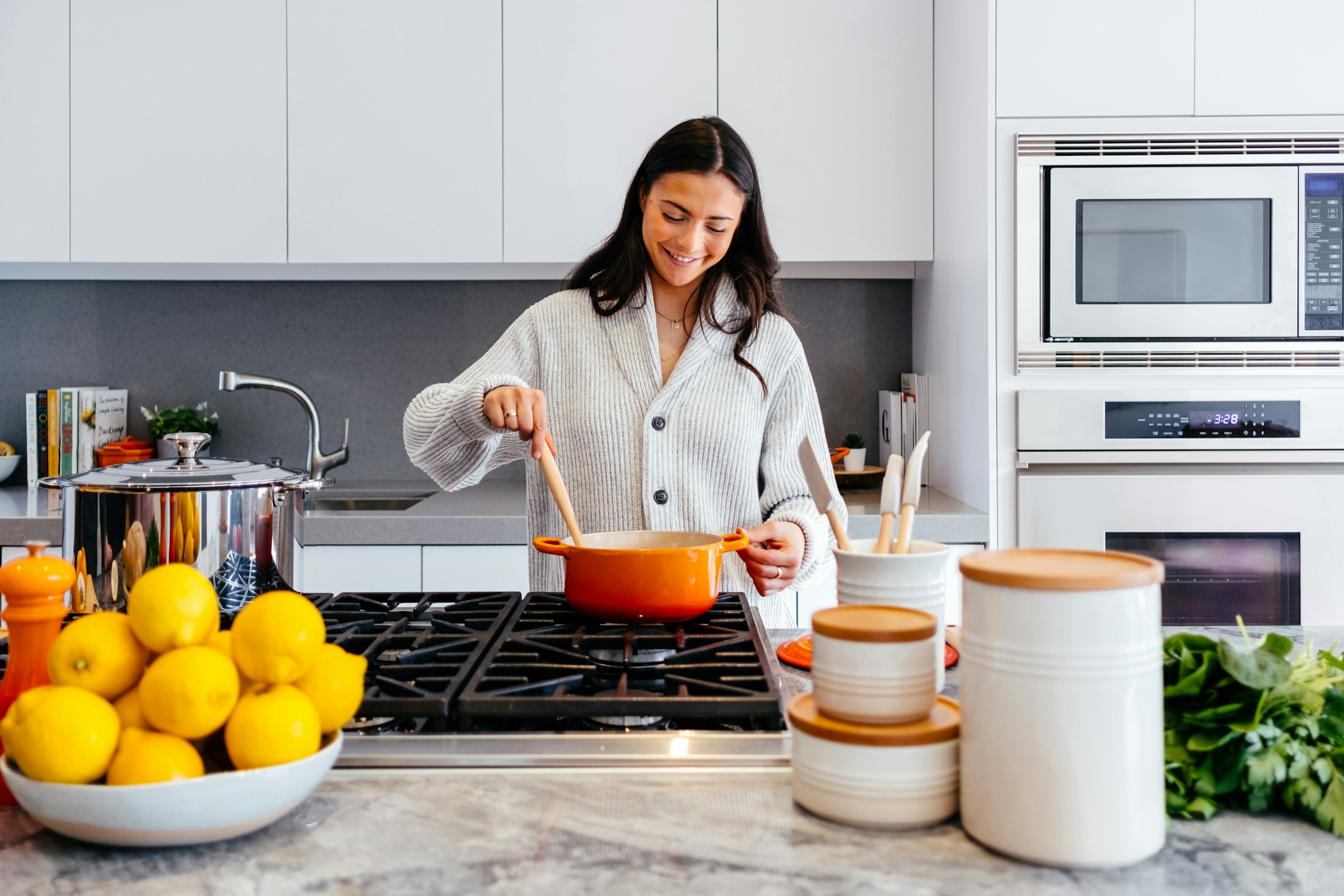In today’s fast-paced lifestyle, meal planning and grocery shopping often feel overwhelming. Thankfully, technology is stepping in to streamline these tasks, making life easier and more efficient. From smart apps that generate grocery lists to online delivery platforms that save time, the innovations transforming our kitchens are astounding. Discover how integrating these tools can enhance your culinary experience, reduce stress, and encourage healthier eating habits. Let’s explore the technological advancements reshaping not just how we cook, but how we think about food.
Overview of Technological Advancements in Kitchen Management
The evolution of kitchen technology has transformed how we manage our culinary spaces. From traditional stoves to smart appliances, the advancements have been remarkable. Meal planning innovations have made it easier for individuals to create balanced diets and manage time efficiently. With apps and devices, one can now plan meals weeks in advance, ensuring a healthy lifestyle without the last-minute rush.
In parallel : Your Ultimate Guide to Choosing and Installing the Perfect Kitchen Greenhouse Window
In terms of grocery shopping tools, technology has introduced various solutions to streamline the process. Online platforms and apps allow users to shop for groceries with a few clicks, often integrating with meal planning tools to suggest products based on planned recipes. This integration not only saves time but also reduces food waste by purchasing only what’s needed.
Looking ahead, the future of kitchen tech is promising. We can expect further advancements in smart appliances, with refrigerators that track food expiry dates and ovens that suggest recipes based on available ingredients. These future trends aim to make kitchen management even more efficient and sustainable, offering solutions that cater to the modern consumer’s needs. As technology continues to evolve, the kitchen is set to become a hub of innovation and convenience.
Also to read : Your Ultimate Guide to Choosing and Caring for Sustainable Quartz Countertops
Essential Apps for Meal Planning
In the realm of meal planning apps, several standout options cater to diverse needs and preferences. These apps not only simplify meal preparation but also enhance recipe management by offering a range of features designed to streamline the cooking process.
When selecting a meal planning app, consider the following features:
- Recipe management capabilities that allow users to save and organize their favourite recipes.
- Integration with grocery shopping tools, enabling seamless transition from planning to purchasing.
- Customizable meal plans that cater to dietary restrictions or preferences.
Cooking tools integrated within these apps often include timers, nutritional information, and step-by-step cooking instructions, making them indispensable for both novice and experienced cooks.
Users have praised these apps for their effectiveness. Testimonials often highlight the time saved in planning and the ease of accessing diverse recipes. One user noted, “The app transformed my cooking routine, making it more efficient and enjoyable.”
By leveraging these meal planning apps, users can achieve a more organized and stress-free cooking experience, ultimately leading to healthier and more varied diets.
Smart Appliances That Enhance Cooking Efficiency
In today’s culinary landscape, smart kitchen appliances have revolutionised the way we cook. These advanced cooking technology tools offer a range of features designed to enhance efficiency and convenience.
Overview of Smart Appliances
The market is brimming with innovative kitchen gadgets. From smart ovens that adjust cooking times and temperatures to suit specific recipes, to refrigerators that suggest meals based on their contents, the options are vast. These appliances often come with connectivity features, allowing users to control them remotely via smartphone apps.
Benefits of Smart Appliances
The primary advantage of using smart appliances is their ability to streamline meal preparation. They offer precision in cooking, reducing the likelihood of under or overcooking meals. Additionally, they save time by automating mundane tasks, such as preheating ovens or adjusting cooking settings.
Integration in Kitchen Workflows
Integrating smart devices into kitchen workflows can significantly enhance productivity. For instance, a smart coffee maker can be programmed to brew coffee at a specific time, ensuring a fresh cup awaits you each morning. These appliances can seamlessly fit into daily routines, making cooking a more enjoyable and efficient process. By embracing these innovations, users can transform their kitchens into hubs of modern efficiency.
Online Grocery Shopping Services
The rise of online grocery shopping has brought convenience to consumers’ doorsteps. With numerous platforms offering grocery delivery, it’s essential to understand their unique offerings. Services like Instacart, Amazon Fresh, and Walmart Grocery have become household names, each providing a distinct shopping experience. Instacart connects users with local stores, offering same-day delivery, while Amazon Fresh integrates with Amazon Prime for a seamless shopping experience. Walmart Grocery focuses on competitive pricing and wide availability.
Advantages of Grocery Delivery Services
Grocery delivery services offer substantial benefits. They save time by eliminating the need for physical store visits and provide the ease of shopping from home. Additionally, they often include features like scheduled deliveries and real-time tracking, enhancing the overall user experience. For those looking to streamline their meal preparation, meal kits from companies like Blue Apron and HelloFresh offer pre-portioned ingredients, reducing food waste and simplifying cooking.
Tips for Maximizing Savings
To make the most of online grocery shopping, consider these tips:
- Compare prices across platforms to find the best deals.
- Utilize subscription services or loyalty programs for discounts.
- Plan purchases around promotions and use digital coupons to reduce costs.
By adopting these strategies, consumers can enjoy the convenience of online shopping without breaking the bank.
Meal Prep Tips Using Technology
Incorporating technology into meal prep can significantly enhance cooking efficiency and save valuable time. By leveraging smart tools and apps, individuals can streamline the preparation process, making it more organised and less time-consuming.
Effective Strategies
One effective strategy is to use meal planning apps that offer organisational features. These apps allow users to schedule meals in advance and provide reminders for ingredient preparation. By planning meals for the week, users can reduce daily cooking stress and ensure they have all necessary ingredients on hand.
Utilising Apps and Tools
Many apps offer features like shopping list automation and recipe suggestions based on dietary preferences. These tools help in maintaining a structured approach to meal prep, ensuring nothing is overlooked. Additionally, using smart kitchen appliances can automate repetitive tasks, such as chopping or mixing, further enhancing efficiency.
Real-Life Examples
Consider a busy professional who uses a meal planning app to schedule meals for the week. By setting aside a couple of hours on the weekend to prepare ingredients, they can quickly assemble meals during the week, saving both time and effort. This approach not only improves cooking efficiency but also promotes healthier eating habits.
Automation and Smart Home Integration
In the era of smart home integration, kitchens have become more than just a place to cook; they are now hubs of innovation. Kitchen automation allows for seamless management of cooking tasks, enhancing both efficiency and convenience.
Automating Kitchen Tasks
Smart home devices can automate various kitchen tasks, from adjusting oven temperatures to managing lighting. For example, smart ovens can be pre-programmed to start baking at a specific time, while intelligent lighting can adjust based on the time of day or cooking activity. This automation not only saves time but also reduces the manual effort involved in meal preparation.
IoT Applications in Kitchens
The Internet of Things (IoT) plays a crucial role in modern kitchens. IoT-enabled refrigerators can track inventory and suggest recipes based on available ingredients. Similarly, smart assistants can create shopping lists or set cooking timers with simple voice commands, streamlining the cooking process and shopping experience.
Benefits of an Integrated Smart Kitchen
A fully integrated smart kitchen offers numerous benefits. It enhances cooking precision, reduces energy consumption, and provides real-time updates on appliance status. By embracing smart home integration, users can enjoy a more efficient, sustainable, and enjoyable cooking environment.
User Benefits from Technology in the Kitchen
Kitchen technology is revolutionising how we approach cooking, offering numerous benefits that enhance both efficiency and enjoyment. By integrating smart tools into daily routines, users experience significant improvements in cooking ease and grocery shopping efficiency.
One of the primary advantages is the enhanced organisation in meal prep. With technology, users can streamline their cooking processes, ensuring meals are prepared quickly and efficiently. This not only saves time but also reduces stress, making cooking a more enjoyable activity for everyone involved.
Moreover, technology plays a crucial role in reducing food waste. Smart appliances and apps help track ingredient usage and suggest recipes based on available items, ensuring nothing goes to waste. This feature not only promotes sustainability but also helps save money by purchasing only necessary ingredients.
Family meal times benefit significantly from these advancements. With less time spent on preparation and more on interaction, families can enjoy meals together without the hassle of lengthy cooking sessions. The ease of technology encourages more frequent home-cooked meals, fostering healthier eating habits and enhancing family bonds. By embracing these innovations, users transform their kitchens into efficient, enjoyable spaces.
Real-Life Examples and Case Studies
Exploring technology success stories in kitchen management reveals transformative impacts on daily routines. Take, for instance, the Johnson family, who integrated smart appliances and meal planning apps into their kitchen. Their experience highlights the seamless transition from traditional cooking to a tech-enhanced culinary space. By using these tools, they reduced meal prep time by 30%, leading to more family time and less stress.
User Experiences
Many users report positive outcomes from adopting kitchen technology. However, challenges such as initial setup and learning curves can arise. One user noted the initial complexity of integrating devices but found the results worthwhile. With perseverance, they achieved enhanced meal planning results, enjoying more varied and nutritious meals.
Key Takeaways
From these user experiences, several key takeaways emerge. First, patience and willingness to adapt are crucial for success. Second, the benefits of technology, such as time savings and improved meal quality, outweigh the initial hurdles. Lastly, families can enjoy more meaningful interactions by reducing time spent on meal preparation, showcasing the potential of kitchen tech to enrich daily life.
Visuals and Step-by-Step Guides
Visual guides and cooking tutorials are indispensable in today’s tech-driven kitchens. They simplify complex processes, making it easier for users to harness the full potential of modern appliances and apps. By providing clear, visual instructions, users can quickly learn how to operate new technology without feeling overwhelmed.
Creating step-by-step guides for popular apps and appliances is crucial. These guides break down tasks into manageable steps, ensuring users can follow along with ease. For instance, a guide might illustrate how to sync a smart oven with a meal planning app, enhancing the cooking experience through seamless integration.
Engaging users with technology walkthroughs is another effective strategy. Incorporating infographics and video content can capture attention and cater to different learning preferences. Videos, in particular, allow users to see the technology in action, providing a practical demonstration that written instructions alone cannot offer.
By using a combination of visual guides, tutorials, and walkthroughs, users can confidently navigate the complexities of kitchen technology. This approach not only boosts user confidence but also enhances the overall cooking experience, making it more efficient and enjoyable.






